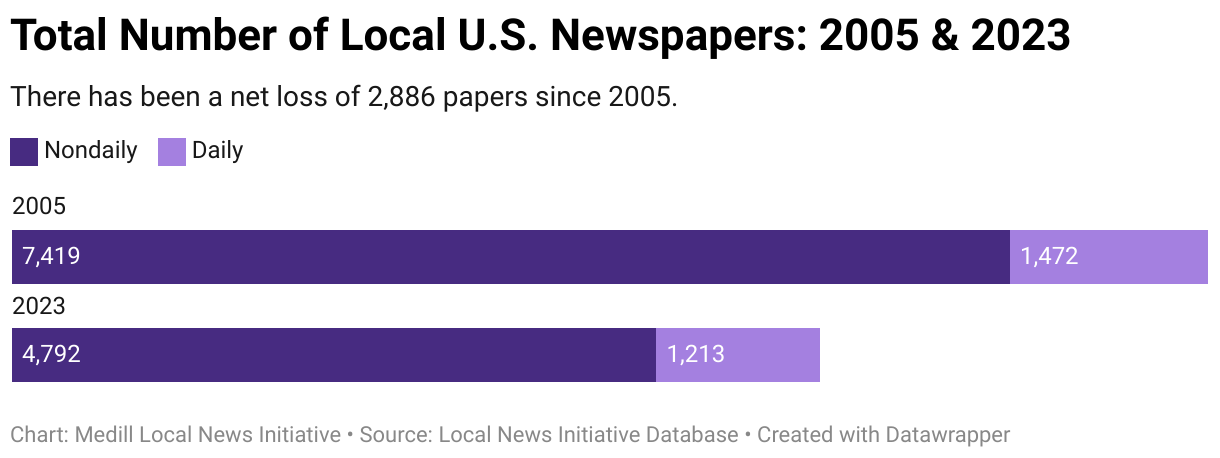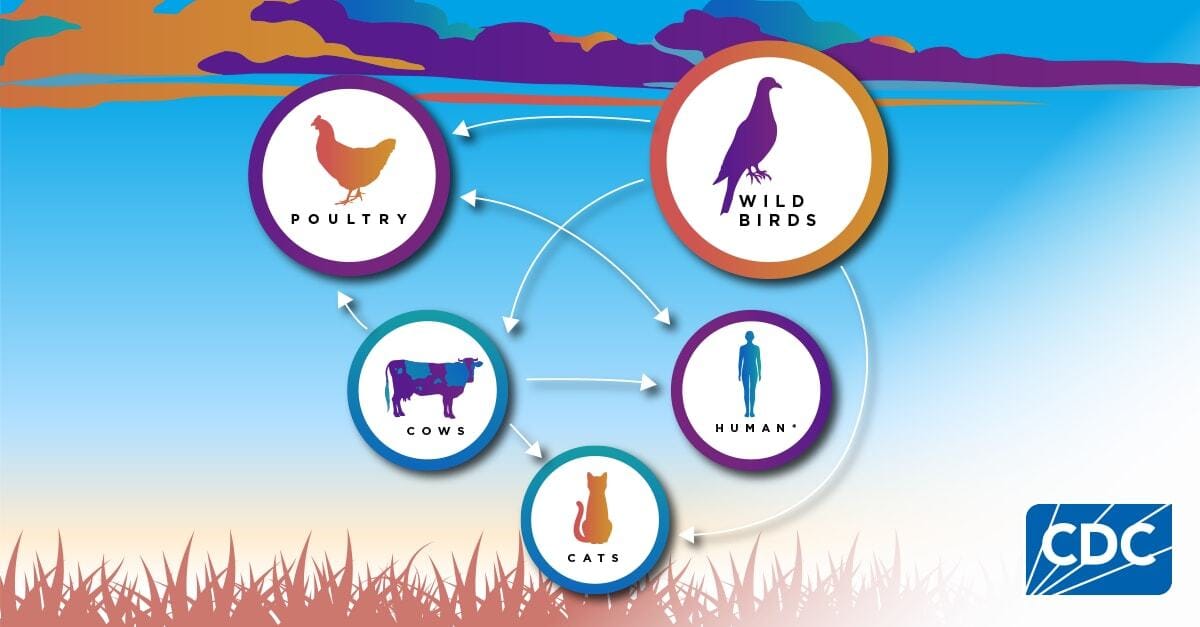TAYO FACT BYTES #2: Our BI-Weekly Informational and Fact Checking Newsletter

Six Minute Read
TAYO FACT BITES #2
Welcome to the second edition of Tayo Fact Bytes, where we give you quick snippets of the latest news and topics that are important to the Filipino American community with lots of links to content that you can read and watch at your leisure. We even have some fun quizzes to see if you can tell the difference between AI generated content and real content. Let’s get knowledgeable.
1. As local news organizations shutter in record numbers, so-called “pink-slime” sites fill the void.
If you are a consumer of local news in your community, it’s no secret that your options have been seriously dwindling for years now. Northwestern University’s Local News Initiative published a report in 2023 on the state of local news, and the findings were sobering:
- Since 2005, almost a third of the newspapers in the United States, both dailies and weeklies, have disappeared due to falling revenues and readership. That amounts to 2,886 local news outlets no longer publishing.
- That leaves 1,213 daily local papers still reporting on important news and information in their communities.

Now comes a new report released in mid-June by the news and information ratings service Newsguard (subscription required) showing that this vacuum in local news has been filled by so-called “pink slime” sites. The term, which originally derives from a meat byproduct, refers to media outlets that hold themselves out as conventional news organizations on the surface but are in fact either clickbait sites designed solely to maximize profit, or partisan operations financed by dark money, i.e. political funding from donors whose identities are obscured or unknown. The sites are filled with low quality content often written by underpaid stringers, bots, and more recently, artificial intelligence: think automated news.
- According to Newsguard there are now 1,265 pink slime sites in the US, which means that “the odds are now better than 50-50 that if you see a news website purporting to cover local news, it’s fake.”
- Pink slime sites are expected to proliferate even more as the 2024 election season heats up and AI automates and turbocharges the publishing of content. 45% of the sites mentioned in the study targeted election swing states like Pennsylvania, Wisconsin, North Carolina, Ohio, Florida, Michigan, and Georgia.
Here’s an interactive map showing the proliferation of pink slime sites across the US, many of which are concentrated in battleground states.

- More than 1,000 pink slime sites have been traced to Metric Media, a complex network of organizations with ties to conservative political groups and founders of the Tea Party movement. Over 5 million articles are published monthly by Metric Media entities.
- Left-leaning groups are also involved in the pink slime explosion but tend to be more upfront about their backers and funding, according to Axios.
- Journalist Ryan Zickgraf, who coined the term “pink slime” in 2012, says that the phenomenon “exploits our faith in local news.”
While content on pink slime sites was often outsourced to low-paid content farms, such as in the Philippines, now the job is being taken over by artificial intelligence. A recent New York Times article examines one particular pink slime site using AI to churn out fake news.
But how sizable of an audience do pink slime news sites attract and what is their actual impact? A 2020 study from Harvard’s Kennedy School suggests that pink slime sites have limited effect on changing people’s opinions and mostly reinforce pre-existing partisan beliefs.
However, the potential impact on elections shouldn’t be discounted altogether. A Stanford University study of pink slime consumption habits in 2023 posits that the goal of pink slime networks “may be to gnaw away at the edges of the consciousness of the voting public or to sow distrust in the online information ecosystem. With election victory margins being extremely narrow in recent years, swinging just a handful of votes could make all the difference.”
2.China raises the stakes in the South China/West Philippine Sea with violence against AFP personnel.
China continued its dramatic aggression in the South China/West Philippine sea on June 17, violently disrupting the Armed Forces of the Philippines (AFP) re-supply mission to the rusting World War II ship BRP Sierra Madre.
- Key Background Facts
- The Sierra Madre has served as a Philippine military garrison on Second Thomas Shoal (known as Ayungin Shoal in Filipino) since 1999.
- Second Thomas Shoal, located 200 nautical miles from the Philippine island of Palawan, and almost 600 nautical miles from China’s Hainan Island, is part of the Spratly Islands chain and sits squarely inside the Philippines Exclusive Economic Zone (EEZ) as prescribed by the United Nations Convention on the Law of the Sea (UNCLOS).
Footage released by the AFP depicts several large Chinese Coast Guard vessels ramming the much smaller and unarmed Philippine military ships, while Chinese military personnel wield pickaxes, knives, lasers, strobe lights and deploy tear gas to create chaos and drive Filipino soldiers away from the shoal. The melee resulted in one Filipino servicemember losing a thumb.
“It was an aggressive and illegal use of force,” said Philippine Defense Secretary Gibo Teodoro on Monday, June 24, during a press conference in Malacañang. “It is a deliberate act of the Chinese officialdom to prevent us from completing our mission.”
Points of Note
- China’s current aggression in the South China/West Philippine Sea has been characterized by international commentators as an example of Gray Zone Tactics.
- Gray Zone Tactics refers to “the use of non-military means – below the threshold of armed conflict – to achieve political objectives.”
- Why does Beijing resort to these measures? A 2023 Time article notes that China is well aware of the mutual defense treaty between the Philippines and the United States, which requires either country to come to the defense of the other in case of armed attack. Gray Zone Tactics are designed to fall below the level of "armed" attack.
- You can read more about how the Chinese government employs the Gray Zone Tactics strategy with this research brief from the Rand Organization.
- China claims nearly 90% of the South China Sea as its territory despite a 2016 ruling by a United Nations arbitral tribunal which found that its claims over areas outside of its EZZ, including the areas surrounding the Second Thomas Shoal, were invalid under UNCLOS. Despite being a signee to the UNCLOS treaty, China refuses to recognize the ruling.
- This rejection of international law, and China's aggression in the South China/West Philippine Sea, has generated regular criticism from the United States, which often scolds Beijing for ignoring the international rules-based order.
However, out of the 168 countries that have ratified UNCLOS–including the Philippines and China–the United States is not one of them. Why has the US not adopted this treaty? And what does that mean for attempts to resolve the vexing South China/West Philippine Sea dispute? Find out more with this report from VOA News.
- This rejection of international law, and China's aggression in the South China/West Philippine Sea, has generated regular criticism from the United States, which often scolds Beijing for ignoring the international rules-based order.
3.Substack: Trusted online publishing platform or home to disinformation?

When it debuted in 2017, Substack promised a new forum for writers and journalists to disseminate their work. The online publishing platform, which allows anyone to start their own subscription-based newsletter, removed the traditional constraints journalists often encounter daily: editors slashing work, nixing ideas, and limiting page views and word counts. As Forbes put it, Substack has given writers “creative, editorial, as well as financial freedom.”
While the platform has attracted a lot of serious and well thought out writing, some of the content it hosts has strayed far beyond the company’s own guidelines and at times even the basic rules of journalistic ethics. Tayo explores in-depth why and how the platform has amassed an entire ecosystem of mis- and disinformation, including newsletters promoting Nazism, white supremacy, anti-COVID-19 vaccine alarmism, and more, including content that purports to benefit Filipinos, but instead trafficks in baseless claims about public health.
To read Tayo's article about Substack, CLICK HERE.
4.“Huwag kang magpa-araw”: Unpacking Colorism in Filipino Culture
Do you ever remember watching Filipino teleseryes and occasionally seeing a blackface character, and not a single person watching in your periphery batted an eye? This silence was more true to life than we thought.
"Don't get too much sun. You'll get darker!" This phrase might seem harmless, often said by relatives who mean well, but it carries a strong message. It hints at preferring lighter skin tones over darker ones, sometimes more directly. Tayo unpacks colorism in-depth and how this way of thinking became so widespread.
Image Description: “Nita Negrita, a 2011 Filipino teleserye (teleseries), using blackface.
5. New FliRT variants see COVID-19 cases rise. H5N1 Bird Flu cases expand.
The new COVID-19 variants, collectively referred to as “FLiRT,” are relatives of the earlier Omicron variant and have been pushing positivity rates higher across the country.
- According to the CDC COVID Data Tracker, COVID test positivity was 9% across the U.S. for the week ending June 29, an increase of 0.8% from the first week in June. Cases are rising in 39 states and they aren’t decreasing anywhere in the US.
- COVID emergency department visits as of June 22nd are up 23.3% from the prior week.
- While viral activity levels are still low nationally, CDC wastewater monitoring shows levels have more than doubled in the western US over the last month.
- Medical experts expect a summer surge but do not believe it will be a major threat to most people due to high levels of immunity. However, immunocompromised individuals and those 65 years and older need to pay special attention.
Bird Flu Cases Continue To Spread
H5N1 avian influenza, otherwise known as bird flu, continues its spread through the US dairy industry. On June 26, the US Department of Agriculture (USDA) Animal and Plant Health Inspection Service (APHIS) confirmed H5N1 avian influenza in three more dairy herds, two in Colorado and one in Iowa, raising the number of affected herds to 129 in 12 states.

- So far, three human cases of bird flu from dairy workers have been linked to the cow outbreak. However, testing among states and farms has lagged, which means there are probably more cases than reported.
- There have been no known cases of bird flu being spread from human to human, but scientists are concerned that the virus could mutate if left unchecked.
- The US government currently has 40 vaccines for bird flu ready to deploy. Finland has already started vaccinating farm workers.
Epidemiologist Katelyn Jetelina has an excellent analysis on the bird flu outbreak in her Substack column.
6. Be careful what you comment on.
This photo of what resembles a Filipino boy and his plastic dog creation was posted to Facebook on March 7 with the caption, “My son made a Dog With plastic. Please Support his talent.” As of July 3, 2024 the post has received nearly 400,000 reactions, 9600 comments, and 14,000 shares. A vast majority of the interactions comes from Filipinos, many of whom were congratulating the young boy for his talent and amazing work of art. There’s only one problem: the photo is 100% AI generated.
To see the actual Facebook post please CLICK HERE.
Here’s some quick tips on how to spot/tell if a photo is AI.
- Washed out details of text (see wrappers of soda.)
- Abnormal lighting
- Poor rendering of hands and ears
For more on how to spot AI generated images, The Guardian has the details.
7. Can you tell the difference between a real photograph and one generated by AI? Try these online quizzes.
Tayo Tipline
Spot any misleading posts recently? Let us know via our Tayo tipline form and we’ll take a deeper look.


